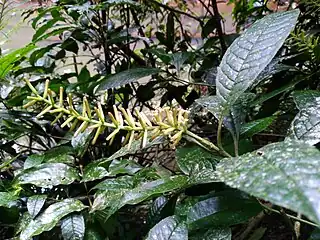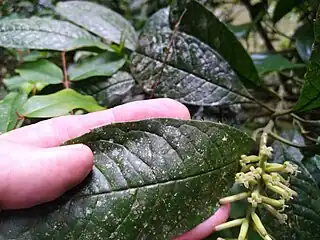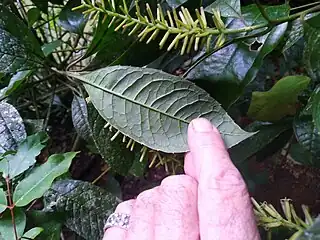| Wrinkled bark polyosma | |
|---|---|
 | |
| In rainforest near Malanda, Sept 2022 | |
| Scientific classification | |
| Kingdom: | Plantae |
| Clade: | Tracheophytes |
| Clade: | Angiosperms |
| Clade: | Eudicots |
| Clade: | Asterids |
| Order: | Escalloniales |
| Family: | Escalloniaceae |
| Genus: | Polyosma |
| Species: | P. rhytophloia |
| Binomial name | |
| Polyosma rhytophloia | |
Polyosma rhytophloia, commonly known as wrinkled bark polyosma, is a plant in the family Escalloniaceae which is endemic to parts of eastern Queensland, Australia.[4][5] It is an evergreen small tree growing up to 11 m (36 ft) high. The glabrous (hairless) leaves may be 7 to 12 cm (2.8 to 4.7 in) long and 2 to 6 cm (0.79 to 2.36 in) wide, with a number of very fine teeth along the margins.[4][5] The veins are prominent on both sides of the blade, and the midrib is often purple on the underside.[4][5]
The inflorescence is a raceme (an unbranched spike) produced in the leaf axils or at the ends of branches.[4][5] The cream/purple flowers are tubular, about 12 mm (0.47 in) long by 3 mm (0.12 in) wide.[4][5] The fruit is a rounded or ovoid, dark purple or black berry containing a single seed. The fruit measures about 12 mm × 10 mm (0.47 in × 0.39 in) and the seed about 9 mm × 7 mm (0.35 in × 0.28 in).[4][5]
Taxonomy
The wrinkled-bark polyosma was first described in 1926 by the Australian botanists Cyril Tenison White and William Douglas Francis, and published in the journal Proceedings of the Royal Society of Queensland.[6]
Etymology
The genus name Polyosma is compounded from the Ancient Greek word poly meaning "many", and the Latin word osma, meaning "odour" or "smell". The species epithet rhytophloia is created from the Ancient Greek words ῥυτίς (rhutís), "wrinkle", and φλόος (phlóos), "bark".[5]
Distribution and habitat
The native range of this species is coastal and sub-coastal ranges of eastern Queensland, from near Cooktown to the area around Eungella, west of Mackay.[5][7] It grows as an understory tree in rainforest, at altitudes from about 520 to 1,300 m (1,710 to 4,270 ft).[4][5]
Conservation
This species is listed by the Queensland Department of Environment and Science as least concern.[1] As of 26 July 2023, it has not been assessed by the International Union for Conservation of Nature (IUCN).
Gallery
 Flower buds
Flower buds Leaf margin
Leaf margin Leaf underside
Leaf underside
References
- 1 2 "Species profile—Polyosma rhytophloia". Queensland Department of Environment and Science. Queensland Government. 2022. Retrieved 26 July 2023.
- ↑ "Polyosma rhytophloia". Australian Plant Name Index (APNI). Centre for Australian National Biodiversity Research, Australian Government. Retrieved 26 July 2023.
- ↑ "Polyosma rhytophloia C.T.White & W.D.Francis". Plants of the World Online. Royal Botanic Gardens, Kew. Retrieved 26 July 2023.
- 1 2 3 4 5 6 7 F.A.Zich; B.P.M.Hyland; T.Whiffen; R.A.Kerrigan (2020). "Polyosma rhytophloia". Australian Tropical Rainforest Plants Edition 8 (RFK8). Centre for Australian National Biodiversity Research (CANBR), Australian Government. Retrieved 26 July 2023.
- 1 2 3 4 5 6 7 8 9 Cooper, Wendy; Cooper, William T. (June 2004). Fruits of the Australian Tropical Rainforest. Clifton Hill, Victoria, Australia: Nokomis Editions. p. 226. ISBN 9780958174213.
- ↑ White, C.T.; Francis, W.D. (1926). "Contributions to the Queensland Flora, no. 3". Proceedings of the Royal Society of Queensland. 37: 158. doi:10.5962/p.351515. S2CID 257130421. Retrieved 27 July 2023.
- ↑ "Search: species: Polyosma rhytophloia | Occurrence records". Australasian Virtual Herbarium. Australian Government. Retrieved 27 July 2023.
External links
 Data related to Polyosma rhytophloia at Wikispecies
Data related to Polyosma rhytophloia at Wikispecies Media related to Polyosma rhytophloia at Wikimedia Commons
Media related to Polyosma rhytophloia at Wikimedia Commons- View a map of historical sightings of this species at the Australasian Virtual Herbarium
- View observations of this species on iNaturalist
- View images of this species on Flickriver